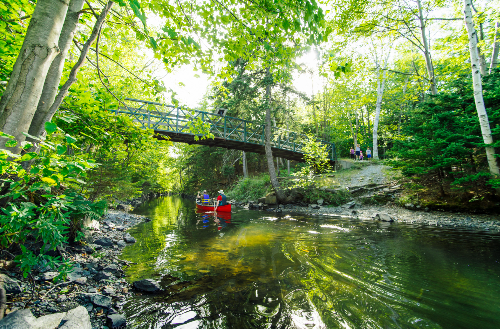Shubenacadie Canal Waterway - Dartmouth, Nova Scotia
The Shubenacadie Canal: Diverse in Nature and History
The Shubenacadie Canal is a canal in main Nova Scotia, Canada. It connects Halifax Harbour with the Bay of Fundy by way of the Shubenacadie River and Shubenacadie Grand Lake. Begun in 1826, it was not completed until 1861 and was closed in 1871. Currently small craft utilize the river and lakes, however only one lock is operational. Three of the 9 locks have actually been restored to maintain their unique blend of British and North American construction techniques. More substantial restoration is prepared.

Experience the natural charm and unique history of the Shubenacadie Canal Waterway! Stretching throughout Nova Scotia from the Halifax Harbour to the Bay of Fundy, website of the world's greatest tides, this 114-kilometre waterway uses diverse recreational opportunities, interpretation, parks, and canal locks built in the 1800s.
Paddle, walk, or cycle the historical canal at Shubie Park, which features a series of well-maintained trails and many interpretive panels. Simply outside downtown Dartmouth and Dartmouth Crossing, Shubie Park is a terrific method to connect with nature in the heart of the city. At the Bay of Fundy end of the waterway, feel the thrill of tidal bore rafting and mud-sliding along the Shubenacadie River.
Tourist attraction highlights include:
- Walk Canal Walk 1 and 2 in downtown Dartmouth to find the Flume House, Sullivan's Pond and Lake Banook
- Check out historic Shubie Park with its interpretive centre and walking trails, including Lock 2, Lock 3, and the Canal Deep Cut
- Take a tidal bore rafting trip on Shubenacadie River
- Go swimming or have a picnic in the shade at Graham's Grove Park on Lake Banook
- Release your boat on Grand Lake at the totally restored Lock 5 in Wellington
- Enjoy stunning Lock 6 Park, path and boardwalk in Enfield
The Shubenacadie Canal was initially surveyed by William Owen in 1767 which caused the proposal of the canal 30 years later. The government of Nova Scotia commissioned Owen to follow the Shubenacadie waterway from the Atlantic Ocean to Cobequid Bay. The Shubenacadie Canal was visualized to facilitate transport between Halifax and the farming, wood and coal producing areas of northern Nova Scotia and the Annapolis Valley. Building and construction was started in 1826 by the Shubenacadie Canal Co. which declared bankruptcy in 1831.
Numerous Scottish and Irish stonemasons had immigrated to Nova Scotia to work on the task however were left stranded in the nest with couple of resources after the project had actually stopped. Building began once again in 1854 under the Inland Navigation Company. The new company altered the initial British stonework lock develops to utilize more affordable North American stone and wood building and construction. Steam boats and barges began to utilize the canal in 1856 and the entire system was completed by 1861. The canal enjoyed a couple of years of healthy traffic specifically during the Waverley gold rushes of the 1860s. However the canal company showed little revenue and experienced numerous problems relating to freezing winter seasons which damaged the locks connecting the freshwater lakes. The president of the Canal business was Michael Wallace.
The canal's continuous building delays were partly responsible for the 1851 choice by Nova Scotia's colonial government to develop the Nova Scotia Railway, which developed lines from Halifax to Windsor and Truro by 1858. Train construction created a short-term surge in canal traffic however a choice in 1870 by the Intercolonial Railway to change the Waverley draw bridge over the canal with a repaired bridge blocked canal steamships and seriously limited canal traffic, a dispute related to the frog wars which pestered rival railways crossings. A final blow was a takeover by the Town of Dartmouth of the Dartmouth Lakes for the city's water supply which ended canal operations in 1871.
If you’re planning a trip to the Shubenacadie Canal, there are a few resources that can help you make the most of your visit. The Nova Scotia Visitor Information Centre is a great place to start. They have six locations throughout the province, including one in Halifax, where you can drop in for information on Nova Scotia’s travel experiences. Their friendly and knowledgeable travel counsellors and tourism ambassadors can help you plan your trip and make the most of your time at the Shubenacadie Canal.
Another useful resource is the Tourism Nova Scotia website. Here you can find information on visitor centres, travel guides, and top attractions and experiences throughout the province.